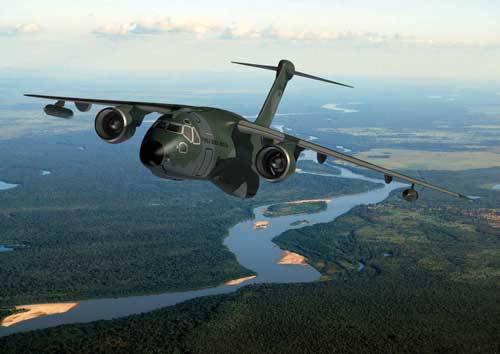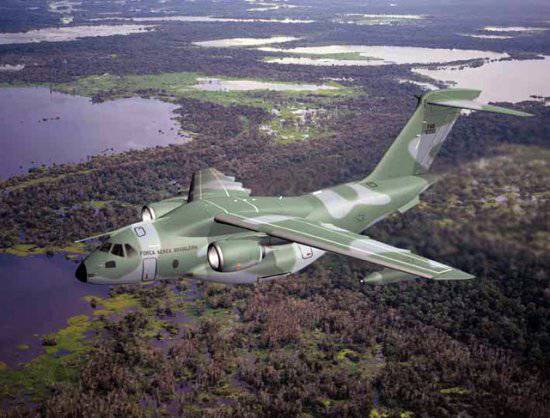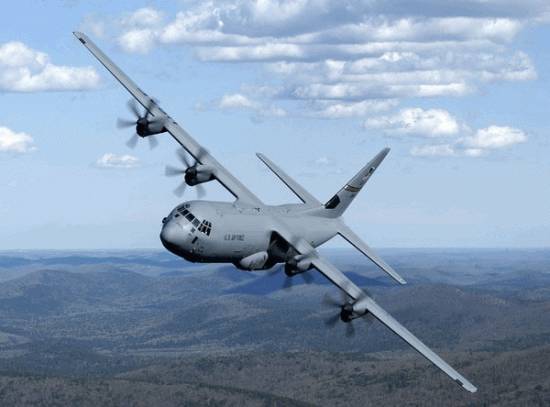Rival Super Hercules from the southern hemisphere

HOPE WASN'T AND ANOTHER ...
Over the past three years, the future fate of KC-390 has been covered in obscurity - the Brazilian Ministry of Defense, although it suggested Embraer to develop a transport worker, it was not in a hurry to place applications for the aircraft. Along with this, there were no firm guarantees that other countries would acquire the car. In addition, most of the work was carried out with Embraer’s own funds - the Brazilian government, having initially invested million dollars in the 33 project, ordered the company to build only two prototypes of the KS-390 prototype for its air forces for testing.
Meanwhile, the program is fully estimated at 500-600 million dollars. This amount includes design and development work, as well as the manufacture of the very prototypes of the transport worker. It should also be borne in mind that the creation of the KC-390 (originally bearing the designation C-390) is an extraordinary task for Embraer: it will be the largest and heaviest aircraft born by the company for all of its history. Previously, the company produced only training machines and regional passenger liners of different classes.
Embraer actually had to rely on the interest of foreign military departments. This would allow both to fully compensate for the development of the aircraft, and stay with a small profit. There was no hope for a large order from the domestic Air Force - from the very beginning they announced that they intended to replace the outdated Lockheed Martin C-390 Hercules with the new KC-23 130. However, the company made a bet that other states will sign large contracts for the supply of transport workers with it in order to also get a worthy successor to many who have served C-130.
Thus, according to Embraer Vice President Luis Carlos Aguilar, around the world, in the next ten years, the Hercules, which have been directly competing with KC-695, will be written off around 390. The advantage of the Brazilian KC-390 over the American C-130 is the cost, with all the other almost identical technical specifications. The estimated cost of one Embraer transporter will be approximately 50 million dollars, while the cheapest Hercules will be 80 million.
The first glimpse on the horizon loomed at the end of 2008 of the year, when Brazil's national postal service Correios announced that it plans to buy five KC-390 airplanes, and later place an order for another 20-25 of such machines. Transport workers are supposed to be used for transportation of parcels, letters and bulky goods. Later, the Brazilian government decided to allocate additional funds for the KC-390 project, and then the Portuguese Ministry of Defense unexpectedly announced plans to replace Embraer with C-130.
At the end of 2009, France and Sweden joined the list of potential buyers of KC-390. However, it is not necessary to seriously rely on future orders from these states - applications for the purchase of a transport company were made as part of the Brazilian tender F-X2, in which the French fighter Dassault Rafale and the Swedish Saab JAS 39 Gripen participate. In fact, each competitor promised to consider the possibility of signing contracts for the supply of KC-390, if it was his aircraft that won the contest.
Embraer went uphill only in 2010, when in July the Brazilian Ministry of Defense announced that it would acquire 28 new transporters for the Air Force in addition to the two prototypes already purchased. Further conclusion of the relevant agreements went at an accelerated pace. In late August, Chile unexpectedly signed an agreement of intent with the Brazilian Ministry of Defense, under which the conditions for the country's participation in the creation of KC-390 will be worked out. At the same time, the Chilean Air Force announced its readiness to buy six transport workers.
In mid-August 2010, Argentina’s Minister of Defense Nilda Garre said that the agency she headed would join the Brazilian KC-390 program and acquire a number of such aircraft. True, she did not name the exact numbers. According to the plans of the Argentine leadership in the next few years, the country's military spending will increase from 0,9 to 1,5 percent of GDP, and the budget of the Ministry of Defense will grow by more than 50 percent. Additional funds are planned to spend on full re-equipment of the ground forces, naval forces and the Air Force.
On September 1, an agreement for the purchase of KS-390 was concluded by the Ministry of Defense of Brazil and Colombia. The Air Force was the last to announce the acquisition of 12 aircraft. Thus, the number of orders for KC-390 almost overnight increased to 46 units.
10 September 2010 of the year decided to join Portugal, which also announced its readiness to buy four Brazilian transport workers. In addition, Portuguese Defense Minister Augusto Santosh Silva stressed that his country expects to take part in the development of the fuselage and wings of the KC-390, including aerodynamic calculations, as well as in the creation of information exchange equipment.
Four days later, the Czech Republic announced its desire to join the project - the corresponding agreement of intent was signed on September 14. The conditions put forward by Prague have not yet been determined. The Czech company Aero Vodochody will presumably be engaged in the production of the rear fuselage, doors and deflectable wing socks.
The achievements of the Brazilian Embarer did not end there - on September 24, negotiations began with the United Arab Emirates Ministry of Defense.
TECHNICAL PART
According to the main project, the Embraer KC-390 is designed according to the layout of a high-wing with a T-tail and two turbofan jet engines. PW390 engines of the American company Pratt & Whitney and BR6000 of the British Rolls-Royce with a thrust of 715-75,6 kilonewtons are considered as options for the KC-98 power plants. They will allow the aircraft to reach speeds of up to Mach 0,8 (about 920 kilometers per hour) and fly fully loaded over distances of up to 2,6 thousand kilometers.
The cargo ramp will be located in the tail end of the aircraft, which can carry not only landing forces, but also various types of equipment. The load capacity of the machine will be 23,6 tons. It should also be noted that in addition to transporting the KC-390, it is to perform the functions of a tanker. To do this, the machine will receive flexible hoses at the ends of the wings in order to produce a simultaneous refueling of two aircraft. It is also possible that in the modified version of the KC-390, a refueling bar will appear in the tail section.
For comparison, the American military transport aircraft C-130J Super Hercules, proposed by Lockheed Martin as a replacement for the obsolete C-130 Hercules, was built according to a high-wing layout layout with a classic tail unit. The machine is equipped with four Rolls-Royce AE2100D3 turboprop engines, which allow the aircraft to fly at a speed of 671 kilometer per hour up to 5,2 thousands of kilometers. Load capacity - 19-20 tons, depending on the modification. C-130J is available in versions of a transport worker, a tanker, a transporting tanker, a patrol aircraft and a meteorological laboratory.
KC-390, obviously, will be presented by several modifications. So, if an order is received from Carreios, the plane will be built as a transport without the possibility of refueling other aircraft. In addition, some of the customers can order a car in the form of a tanker, where the cargo compartment will be replaced with additional fuel tanks. At the same time, the Brazilian media do not exclude the possibility of creating KC-390 variants for the ground forces and Brazilian navy. However, this information is not yet officially confirmed.
Embraer assumes that the first flight of the KC-390 will take place in 2014, and the delivery of the first serial transporters of the Brazilian Air Force will begin in 2016. In the future, it is planned to open production of parts for the KS-390 in the countries of the project partners, which will allow Embraer to increase the production of mass-produced aircraft. According to Embraer, the number of orders for KC-390 will increase closer to the expansion of mass production. First of all, the clients of the Brazilian company will be the countries of Latin America, most of which have already begun implementing their own programs for the modernization of the armed forces.


Information